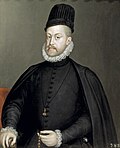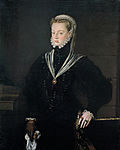Charles V, Holy Roman Emperor
Holy Roman Emperor from 1519 to 1556 From Wikipedia, the free encyclopedia
Remove ads
Charles V (24 February 1500 – 21 September 1558) was Holy Roman Emperor from 1519, King of Castile and Aragon from 1516, and Lord of the Low Countries as Duke of Burgundy from 1506.
Philip the Handsome (son of Maximilian I of Austria and Mary of Burgundy) and Joanna the Mad (daughter of Ferdinand II of Aragon and Isabella I of Castile) were his parents. He ruled Austria, Spain, Two Sicilies, Sardinia, Germany, Belgium, Holland, Luxembourg, Hungary, Bohemia, Croatia, Mexico, Peru, and Venezuela.
His Majesty or His Imperial Majesty was first used when he was king. His Empire became large and was known as "in which the sun does not set". He was also known as "The Emperor of Universal Dominion."
He divided his empire between his brother Ferdinand I, Holy Roman Emperor and his son Philip II of Spain.
Remove ads
Issue
Charles and Isabella had seven legitimate children, but only three of them survived to adulthood. Charles also had natural children before he married and after he was widowed.
Due to Philip II being a grandson of Manuel I of Portugal through his mother he was in the line of succession to the throne of Portugal, and claimed it after his uncle's death (Henry, the Cardinal-King, in 1580), thus establishing the personal union between Spain and Portugal.
Charles also had six children out of wedlock:
- Infanta Isabella of Castile (20 August 1518 – 1537), perhaps daughter of Charles's maternal step-grandmother, Germaine of Foix,[23] but strongly disputed by biographer Geoffrey Parker;[24] Isabella died at the age of 19, never married, and had no issue.
- Margaret of Austria (1522–1586), daughter of Johanna Maria van der Gheynst, who Charles recognized[25][26] a servant of Charles I de Lalaing, Seigneur de Montigny, daughter of Gilles Johann van der Gheynst and wife Johanna van der Caye van Cocamby. Married firstly with Alessandro de' Medici, Duke of Florence, and secondly with Ottavio Farnese, Duke of Parma.
- Joanna of Austria (1522–1530), daughter of Catalina de Rebolledo (or de Xériga), lady-in-waiting of Queen Joanna I of Castile and Aragon[27] or attached to the household of Henry of Nassau. She was brought up in an Augustinian convent in Madrigal de las Altas Torres.[25]
- Tadea of Austria (1523? – c. 1562), daughter of Orsolina della Penna. Married to Sinibaldo di Copeschi.[28]
- Cornelis de Hooghe (1541-1583), Dutch cartographer
- John of Austria (1547–1578), victor of the Battle of Lepanto, son of Barbara Blomberg.[29]
Remove ads
Notes
- The chronology of his abdications has been disputed since early scholarship.[1] His public abdication to the States General of the Netherlands certainly took place on 25 October 1555.[1][2] His abdication as Spanish king is generally dated to 16 January 1556, although some give other dates.[1] This was ratified in a document dated 17 February.[1] On 3 August, he announced his abdication as emperor and instructed his commissioners to negotiate with Ferdinand and the electors the formal transfer of power.[3][4] On 27 August, Charles wrote a document to the Imperial court in Speyer (referred to as a Constitutio or Rescriptum) renouncing the Empire in favour of Ferdinand.[5][6] Then, on 7 September, he sent an edict to all States of the Empire urging them to recognize Ferdinand as their new ruler.[5][7] The abdication was not recognized by the electors until 24[14] (or 28)[20] February 1558. Ferdinand was finally proclaimed and crowned Emperor-elect on 14 March,[12] after sworing the Electoral capitulation.[21]
- Monarchs from the House of Habsburg ruled the Low Countries with the titular title of Duke/Duchess of Burgundy.
Remove ads
Regnal titles of Charles V
References
Wikiwand - on
Seamless Wikipedia browsing. On steroids.
Remove ads






